PLANNED BULKING WITH DUAL-PURPOk VEHICLES
Page 56
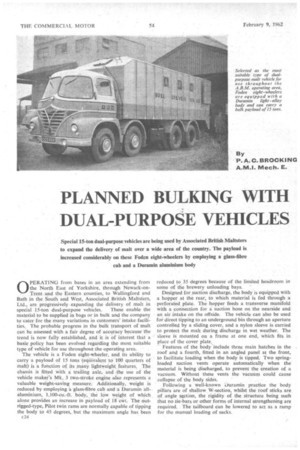
Page 57
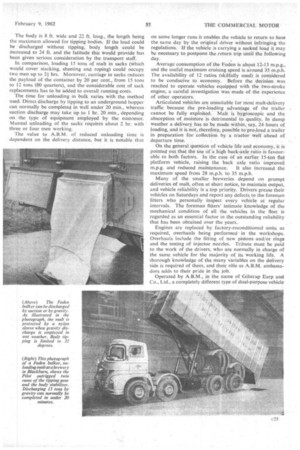
Page 58
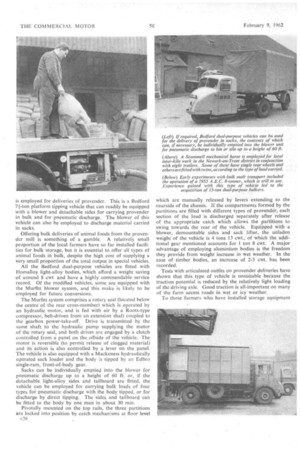
Page 59
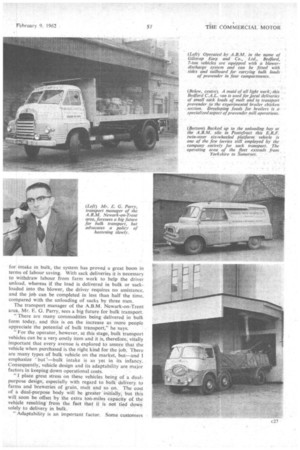
Page 60
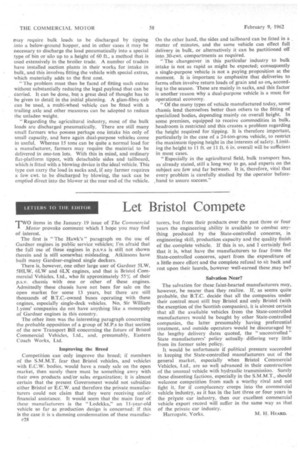
If you've noticed an error in this article please click here to report it so we can fix it.
Special 15-ton dual-purpose vehicles are being used by Associated British Maltsters to expand the delivery of malt over a wide area of the country. The payload is increased considerably on these Foden eight-wheelers by employing a glass-fibre cab and a Duramin aluminium body
By P. A. C. BROCK ING A.M.I. Mech. E.
0 PERATING from bases in an area extending from the North East of Yorkshire, through Newark-on
• .Itent. and the Eastern counties, to Wallingford and. Bath in the South and West, Associated British Maltsters, Ltd., are progressively, expanding the delivery of malt in special 15-ton dual-purpose vehicles. These enable the material to be supplied in bags or in bulk and the company to cater for the Many variations in customers' intake facilities.. The probable progress in the. bulk transport of malt can be assessed with a fair degree of accuracy because the trend is now fully established, and it is of interest that a basic policy has been evolved regarding the most suitable type of vehicle for use throughout theoperating area.
The vehicle is a Foden eight-wheeler, and its ability to carry a payload of 15 tons (equivalent to 100 quartets of malt) is .a function of its many lightweight "features, . The chassis is fitted With a trailing axle, and the use of the vehicle maker's Mk.. 3 two-stroke engine also represents a valuable weight-saving measure, .• Additionally, weight is reduced by employing a glass-fibre cab and 'a Duramin allaluminium, 1,100-cu.-ft. body, the low weight of which alone provides an increase in payload of 18 okt. The outrigged-type, Pilot twin rams are normally capable of tipping the body to 45 degrees, but the maximum angle has been
reduced to 35 degrees because of the limited headroom in some of the brewery unloading bays. '
Designed for suction discharge, the body is equipped with a. hopper, at the rear, to which material is fed through a perforated plate. The hopper feeds a transverse manifold with a connection for a suction hose on the. nearside and an air intake on the offside. The vehicle can also be used for direct tipping to an underground bin through an aperture controlled by a sliding cover, and a nylon sleeve is carried to protect the malt during discharge in wet weather. The sleeve is mounted on a frame at one end, which fits in place of the cover plate..
Features of the body include three main hatches in the roof and a fourth, fitted in an angled panel at the frOnt, to facilitate loading when the body is tipped. Two springloaded suction vents operate automatically when the material is being -discharged, to prevent the creation of a vacuum. Without these vents the vacuum could cause collapse of the body sides.
Following a well-known i/uramin practice the body pillars are of shallow, W-section, whilst the roof sticks are of angle s.qctiOn, the rigidity, of the structure being such that no ,tie-bars or other forms of internal strengthening are required. The tailboard can be lowered to act as a ramp for the manual loading of sacks. The body is 8 ft. wide and 22 ft. long., the length being the maximum allowed for tipping bodies. If the load could be discharged without tipping, body length could be increased to 24 ft. and the latitude this would provide has been given serious consideration by the transport staff.
In comparison, loading 15 tons of malt in sacks (which would cover stacking, sheeting and roping) could occupy two men up to 21 hrs. Moreover, carriage in sacks reduces the payload of the container by 20 per cent., from 15 tons to 12 tons (80 quarters), and the considerable cost of sack replacements has to be added to overall running costs.
The time for unloading in bulk varies with the method used. Direct discharge by tipping to an underground hopper can normally be completed in well under 20 mm., whereas suction discharge may take up to 1 hr. 20 mm., depending on. the type of equipment employed by the customer. Manual unloading of the sacks requires about 2 hr. with three or four men working.
The value to A.B.M. of reduced unloading time is dependent on the delivery distance, but it is notable that on some longer runs it enables the vehicle to return to base the same day by the original driver without infringing the regulations. If the vehicle is carrying a sacked load it may be necessary to postpone the return trip until the following day.
Average consumption of the Foden is about 12-13 m.p.g., and the useful maximum cruising speed is around 35 m.p.h. The availability of 12 ratios (skilfully used) is considered to be conducive to economy. Before the decision was reached to operate vehicles equipped with the two-stroke engine, a careful investigation was made of the experience of other operators.
Articulated vehicles are unsuitable for most malt-delivery traffic because the pre-loading advantage of the trailer cannot be fully exploited. Malt is hygroscopic and the absorption of moisture is detrimental to quality. In damp weather a delivery has to be made within, say, 24 hours of loading, and it is not, therefore, possible to pre-load a trailer in preparation for collection by a tractor well ahead of departure time.
On the general question of vehicle life and economy, it is pointed out that the use of a high back-axle ratio is favourable to both factors. In the case of an earlier 15-ton flat platform vehicle, raising the back axle ratio improved m.p.g. and reduced maintenance. It also increased the maximum speed from 28 m.p.h. to 35 m.p.h.
Many of the smaller breweries depend on prompt deliveries of malt, often at short notice, to maintain output, and vehicle reliability is a top priority. Drivers grease their vehicles on Saturdays and report any, defects to the foreman fitters who personally inspect every vehicle at regular intervals. The foreman fittersintimate knowledge of the mechanical condition of all the vehicles in the fleet is regarded as an essential factor in the outstanding reliability that has been obtained over the years.
Engines are replaced by factory-reconditioned eunits as required, overhauls being performed in the workshops. Overhauls include the fitting of new pistons and/or rings and the testing of injector nozzles. Tribute must be paid to the work of the drivers, who are normally in charge of the same vehicle for the majority of its working life. A thorough knowledge of the many variables on the delivery side is required of them, and their role as A.B.M. ambassadors adds to their pride in the job.
Operated by A.B.M., in the name of Gilstrap Earp and Co., Ltd., a completely different type of dual-purpose vehicle is employed for deliveries of provender. This is a Bedford 71-ton platform tipping vehicle that can readily be equipped with a blower and detachable sides for carrying provender in bulk and for pneumatic discharge. The blower of this vehicle can also be employed to discharge material carried in sacks.
Offering bulk deliveries of animal foods from. the provender mill is something of a gamble. A relatively small proportion of the local farmers have so far installed facilities for bulk storage, but it is essential to offer all types of animal foods in bulk, despite the high cost of supplying a very small proportion of the total output in special vehicles.
All the Bedford dual-purpose vehicles are fitted with Homalloy light-alloy bodies, which afford a weight saving of around 8 cwt and have a highly commendable service record. Of the modified vehicles, some are equipped with the Murfitt blower system, and this make is likely to be employed for future conversions.
The Murat system comprises a rotary seal (located below the centre of the rear cross-member) which is operated by an hydraulic motor, and is fed with air by a Roots-type compressor, belt-driven from an extension shaft coupled to the gearbox power-take-off. Drive is transmitted by the same shaft to the hydraulic pump supplying the motor of the rotary seal, and both drives are engaged by a dutch controlled from a panel on the offside of the vehicle, The motor is reversible (to permit release of clogged material) and its .action is also controlled by a lever on the panel. The Vehicle is also equipped with a Mackeness hydraulically operated sack loader and the body is tipped by an Edbro single-ram, front-of-body gear.
Sacks can be .individually emptied into the blower for pneumatic discharge up to a height of 60 ft. or, if the detachable light-alloy . sides and tailboard are fitted, the vehicle can be employed for carrying bulk, loads of four types for pneumatic discharge with the body tipped, or for discharge by direct' tipping. The sides and tailboard can be fitted to the body by one man in about 30 min.
Pivotally mounted on the top rails, the three partitions are locked into position by catch mechanisms at floor level c26 which are manually released by levers extending to the nearside of the chassis. lithe compartments formed by the partitions are filled with different types of provender, each section of the load is discharged separately after release of the appropriate catch which allows the partitions to swing towards the rear of the vehicle. Equipped with a blower, demountable sides and sack lifter, the unladen weight of the vehicle is 4 tons 13 cwt., of which the additional gear mentioned accounts for 1 ton 8 cwt. A major advantage of employing aluminium bodies is the freedom they provide from weight increase in wet weather, In the case of timber bodies, an increase of 2-3 cwt. has been recorded.
Tests with articulated outfits on provender deliveries have shown that this type of vehicle is unsuitable because the traction potential is reduced by the relatively light loading of the driving axle. Good traction is all-important on many of the farm access roads in wet or icy weather.
To those farmers who have installed storage equipment
for intake in bulk, the system has proved a great boon in terms of labour saving. With sack deliveries it is necessary to withdraw labour front farm work to help the driver unload, whereas if the load is delivered in bulk or sackloaded into the blower, the driver requires no assistance, and the job can be completed in less than half the time. compared with the unloading of sacks by three men.
The transport manager of the A.B.M. Newark-on-Trent area, Mr. E. G. Parry, sees a big future for bulk transport.
"There are many commodities being delivered. in bulk form today, and this is on the increase as more people appreciate the potential of bulk transport," he says.
"For the operator, however, at this stage, bulk transport vehicles can be a very costly item and it is, therefore, vitally important that every avenue is explored to assure that the vehicle when purchased is the right kind for the job. There are many types of bulk vehicle on the market, but—and I emphasize 'but '—bulk intake is as yet in its infancy. Consequently, vehicle design and its adaptability are major factors in keeping down operational costs.
"I place great stress on these vehicles being of a dual-. purpose design, especially with regard to bulk delivery to farms and breweries of grain, malt and so on. The cost of a dual-purpose body will be greater initially; but this will soon be offset by the extra ton-miles capacity of the vehicle resulting from the tact that it is not tied down solely to delivery in bulk.
"Adaptability is an important factor. Some customers may require bulk loads to be discharged by tipping into a below-ground hopper, and in other cases it may be necessary to discharge the load pneumatically into a special type of bin or silo up to a height of 60 ft., a method that is used extensively in the broiler trade. A number of traders have installed suction plants in their works for intake in bulk, and this involves fitting the vehicle with special extras, which materially adds to the first cost.
"The problem must then be faced of fitting such extras without substantially reducing the legal payload that can be carried. It can be done, but a great deal of thought has to be given to detail in the initial planning. A glass-fibre cab can be used, a multi-wheel vehicle can be fitted with a trailing axle and other measures can be adopted to reduce the unladen weight.
"Regarding the agricultural industry, most of the bulk loads are discharged pneumatically. There are still many small farmers who possess perhaps one intake bin only of small capacity, and here again dual-purpose vehicles come in useful. Whereas 15 tons can be quite a normal load for a manufacturer, farmers may require the material to be delivered in one-ton lots. With this in mind, and ordinary flat-platform tipper, with detachable sides and tailboard, which is fitted with a blowing device is the ideal vehicle. This type can carry the load in sacks and, if any farmer requires a few cwt. to be discharged by blowing, the sack can be emptied direct into the blower at the rear end of the vehicle. On the other hand, the sides and tailboard can be fitted in a matter of minutes, and the same vehicle can effect full delivery in bulk, or alternatively it can be partitioned off into, 30-cwt. compartments as required.
"The changeover in this particular industry to bulk intake is not as rapid as might be expected; consequently a single-purpose vehicle is not a paying proposition at the moment. It is important to emphasize that deliveries to farms often involve return loads of grain and so on4 according to the season. These are mainly in sacks, and this factor is another reason why a dual-purpose vehicle is a must for operational economy.
"Of the many types of vehicle manufactured today, some chassis lend themselves better than others to the fitting of specialized bodies, depending mainly on overall height. In some premises, equipped to receive commodities in bulk, headroom is restricted and this creates a problem regarding the height required for tipping. It is therefore important, particularly in the case of a 24-tan-gross vehicle, to restrict the maximum tipping height in the interests of safety. Limiting the height to 11 ft. or 11 ft. 6 in. overall will be sufficient in most cases.
"Especially in the agricultural field, bulk transport • has, as already stated, still a long way to go, and experts on the subject are few and far between, It is, therefore, vital that every problem is carefully studied by the operator beforehand to assure success."
















































































































